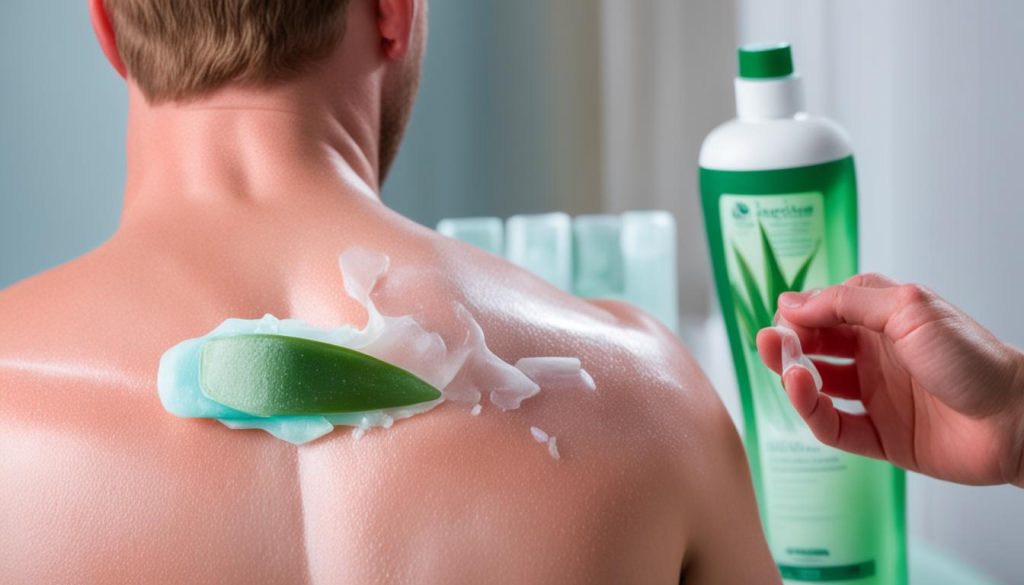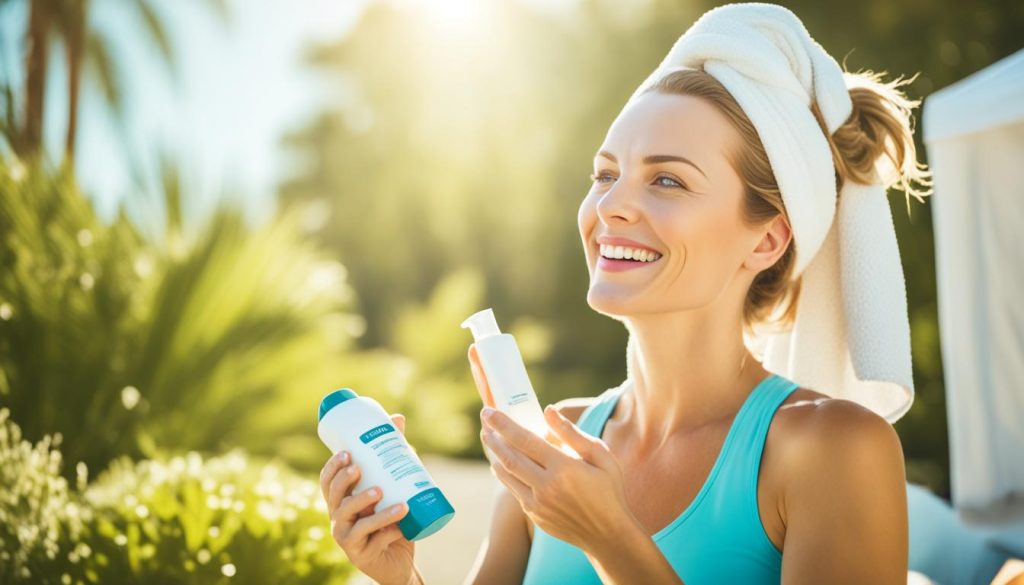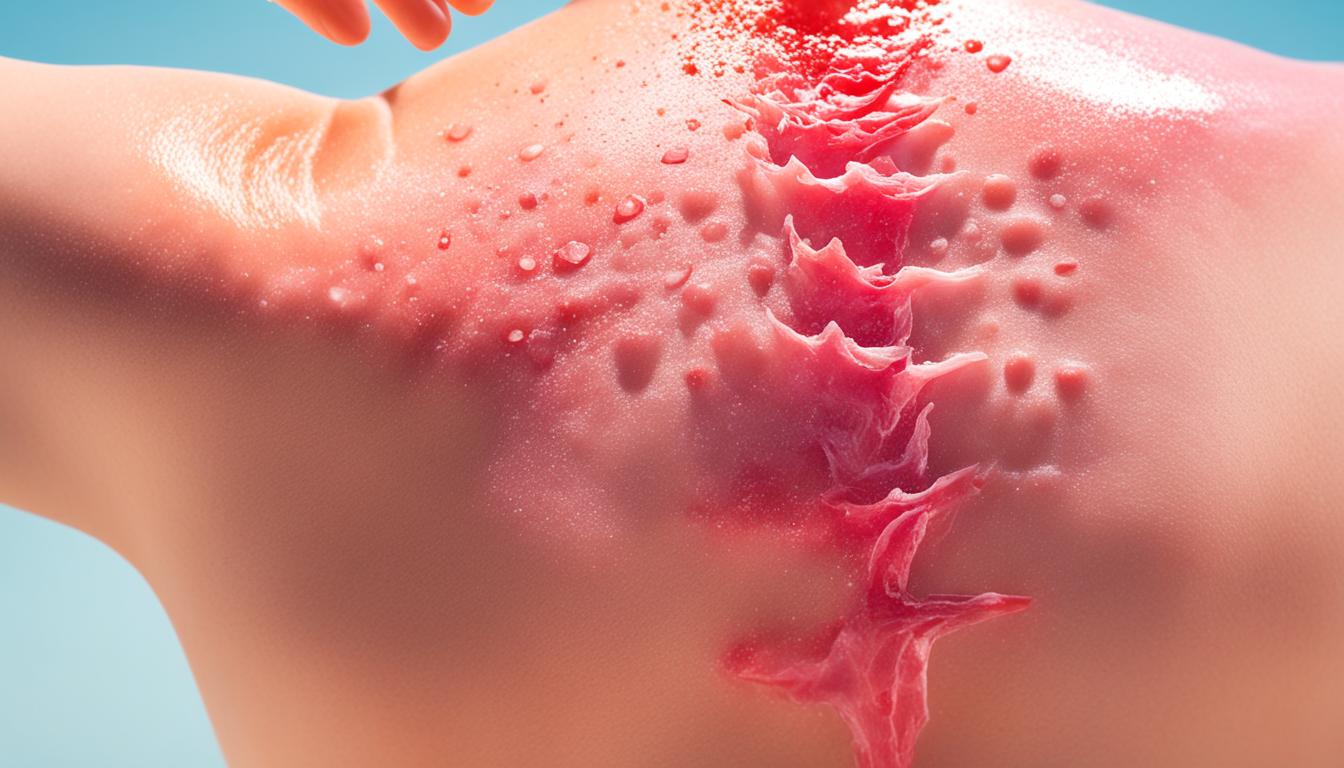Are you wondering how long it takes for a sunburn to heal? Sunburns can be not only uncomfortable but also potentially dangerous. Sunburn is skin damage caused by the ultraviolet (UV) rays of the sun, resulting in redness, soreness, warmth, tenderness, and itchiness. It is important to understand the healing process and treatment options to ensure a speedy recovery.
Sunburns typically last for about a week, during which the skin may become red and inflamed. In some cases, the affected areas may also blister and peel. The duration of sunburn healing can vary depending on the severity of the burn and individual factors.
To expedite the healing process, it is essential to take appropriate measures. This includes cooling the skin with cold compresses, drinking plenty of fluids to stay hydrated, and taking over-the-counter pain relief medication if needed. Avoiding further sun exposure and seeking medical advice in severe cases is also crucial.
Understanding the symptoms, treatment duration, and recovery timeline of sunburns can help you manage the condition more effectively. In the following sections, we will explore the duration and treatment of mild, moderate, and severe sunburns, as well as factors that can affect sunburn recovery. We will also provide valuable tips on sunburn prevention and protection.
Stay tuned to learn more about how to speed up sunburn healing and achieve quick relief!
How Long Does It Take for a Sunburn to Heal?
Symptoms and Duration of Mild Sunburns
Mild sunburns can cause discomfort and irritation, but they often heal relatively quickly. Understanding the symptoms and duration of mild sunburns can help you manage the condition effectively and promote faster healing.
Symptoms of Mild Sunburns
When you have a mild sunburn, you may experience the following symptoms:
- Redness: The affected area of the skin may appear red or pink.
- Pain: Mild sunburns can cause tenderness and sensitivity to touch.
- Peeling: Towards the end of the healing process, the skin may start to peel.
It’s important to note that the severity of these symptoms may vary from person to person.
Duration of Mild Sunburns
Mild sunburns typically last for about three to five days. During this time, you may experience discomfort and mild pain. As the skin heals, any redness will gradually fade, and peeling may occur. It’s crucial to avoid further sun exposure and protect the affected areas from direct sunlight during the healing process.
Using home remedies and taking care of your skin can help promote healing and alleviate discomfort. Cold compresses, moisturizing lotions, and over-the-counter pain relief medications can provide relief from symptoms.
Remember, if your symptoms worsen or you experience severe pain or other concerning symptoms, it’s essential to seek medical attention for a proper evaluation and guidance.

Duration and Treatment of Moderate Sunburns
Moderate sunburns can be more painful and may exhibit symptoms such as redness, swelling, and hotness of the skin. Unlike mild sunburns, moderate sunburns may require more time to heal completely. On average, it takes about a week for moderate sunburns to fully recover. However, in the following days, additional peeling of the skin may occur, which is a normal part of the healing process.
If you are experiencing a moderate sunburn, it is crucial to seek appropriate treatment to alleviate discomfort and promote healing. While mild sunburns can often be managed with home remedies, moderate sunburns may require medical attention, especially in severe cases.
Treatment for moderate sunburns may involve:
- Hydrocortisone cream: Applying a hydrocortisone cream can help reduce inflammation and soothe the affected skin.
- Burn dressings: Using specialized burn dressings can provide protection to the sunburned areas and prevent infection.
- Hospital treatment: In severe cases, hospital treatment may be necessary. This can include intravenous fluids, pain management, and monitoring for complications.
During the healing process, it is essential to avoid further sun exposure, as this can worsen the symptoms and delay the recovery. Additionally, staying hydrated by drinking plenty of fluids can support the healing process and prevent dehydration.
Remember, everyone’s healing process may vary, so it’s important to monitor your symptoms and consult a healthcare professional if you have any concerns about your moderate sunburn.

| Treatment for Moderate Sunburns | Description |
|---|---|
| Hydrocortisone cream | Reduces inflammation and soothes the affected skin |
| Burn dressings | Provides protection to the sunburned areas and prevents infection |
| Hospital treatment | Necessary for severe cases, including intravenous fluids, pain management, and monitoring for complications |
Recovery Time for Severe Sunburns
Severe sunburns can be extremely painful and result in blistering and intense redness. The recovery time for severe sunburns can vary, but it generally takes up to two weeks for the skin to heal completely. During this time, it is crucial to take proper care of the affected area to promote faster healing and prevent further damage or infection.
Resting and staying home are usually necessary for the healing process to occur efficiently. It’s important to avoid prolonged sun exposure and continue to protect the skin from UV rays. Applying cool compresses and moisturizers can help soothe the skin and alleviate discomfort. Over-the-counter pain medication can also be used to manage pain and inflammation.
It is essential to seek immediate medical attention if fever or other severe symptoms develop. A healthcare professional can assess the severity of the sunburn and provide appropriate treatment if needed. They may recommend topical ointments, such as corticosteroids, to reduce inflammation and promote healing.
During the recovery period, the skin may peel for several weeks. It is crucial to avoid picking or scratching at the skin as it can lead to further damage and increase the risk of infection. Keeping the skin moisturized and protected from sunlight can aid in the healing process.

| Severe Sunburn Recovery Tips |
|---|
| Rest and limit physical activity to promote healing. |
| Avoid sun exposure and protect the skin with clothing and sunscreen. |
| Apply cool compresses or take cool baths to soothe the skin. |
| Moisturize the skin regularly to prevent dryness and peeling. |
| Take over-the-counter pain relievers to alleviate discomfort. |
| Seek medical attention for severe symptoms or complications. |
| Avoid picking or scratching at the skin to prevent infection. |
Factors Affecting Sunburn Duration
Several factors can influence the duration of sunburn. People with fair or light skin, freckles, red or fair hair, and a tendency to burn rather than tan are more susceptible to severe sunburn and longer recovery periods. Other factors include sun exposure during peak hours, high altitudes, and living or visiting places near the equator. Medications, such as photosensitizing drugs, can also increase sunburn susceptibility.
When it comes to sunburn, not all individuals experience the same healing time. Let’s take a closer look at the factors that can affect the duration of sunburn and the susceptibility of individuals to burns.
- Fair or light skin: Those with fair or light skin have less melanin, the pigment that provides some protection against UV radiation. As a result, they are more likely to burn and take longer to heal.
- Freckles and red or fair hair: Individuals with freckles or red or fair hair tend to have less protective melanin, making them more susceptible to sunburn.
- Tendency to burn rather than tan: Some individuals have a genetic predisposition to burn easily when exposed to the sun, resulting in longer recovery times.
- Sun exposure during peak hours: Sunburns are more likely to occur when the sun’s UV rays are at their strongest, typically between 10 am and 4 pm. Prolonged exposure during these hours can increase the severity and duration of sunburn.
- High altitudes: At higher altitudes, UV radiation is stronger due to thinner air, resulting in a higher risk of sunburn and longer recovery times.
- Living or visiting places near the equator: Near the equator, the sun’s rays are more direct, leading to increased intensity and a greater susceptibility to sunburn.
- Medications: Certain medications, such as photosensitizing drugs, can make the skin more sensitive to sunlight and increase the risk of sunburn.
Sunburn Prevention and Protection
To prevent sunburn, it’s important to protect the skin from harmful UV rays. Here are some effective strategies for sunburn prevention and protection:
1. Wear Suitable Clothing
When spending time outdoors, wear wide-brimmed hats and long-sleeved tops to shield your skin from direct sunlight. Light and loose-fitting clothing can also provide an extra layer of protection.
2. Seek Shade
Take advantage of shaded areas such as trees or umbrellas. Limiting direct exposure to the sun can significantly reduce the risk of sunburn.
3. Use Sunscreen
Apply sunscreen generously to all exposed skin areas. Choose a broad-spectrum sunscreen with a Sun Protection Factor (SPF) of 30 or higher and look for products that offer UVA and UVB protection.
4. Be Mindful of Sunburn Risk Factors
Understand that sunburn risk varies depending on various factors. While sunburn risk is highest from March to October in the UK, it’s important to note that sunburn can still occur in other weather conditions. Additionally, certain surfaces like snow, sand, concrete, and water can reflect sunlight, increasing the risk of sunburn.
By taking these preventive measures, you can minimize the chances of getting sunburned and protect your skin from harmful UV rays.

| Risk Factors | Preventive Measures |
|---|---|
| Fair or light skin | Wear protective clothing and apply sunscreen regularly. |
| Freckles | Seek shade and use sunscreen to avoid excessive sun exposure. |
| Red or fair hair | Wear hats and protective clothing to shield the scalp and sensitive areas. |
| Tendency to burn rather than tan | Use a broad-spectrum sunscreen and limit sun exposure during peak hours. |
| Sun exposure during peak hours | Seek shade and avoid spending prolonged periods in direct sunlight. |
| Living or visiting places near the equator | Take extra precautions, such as wearing protective clothing and using sunscreen with a higher SPF. |
| Medications (photosensitizing drugs) | Consult your healthcare provider about sunburn risks associated with your medications and take appropriate precautions. |
Conclusion
Sunburns can be painful and damaging to the skin, but with proper care and treatment, they can heal within a few days to weeks. To prevent sunburn, it’s important to protect the skin from UV exposure and take precautions.
Sunburn prevention tips: Wear protective clothing like wide-brimmed hats and long-sleeved tops, seek shade during peak sun hours, and use sunscreen with a high SPF and UVA/UVB protection. Remember that sunburn risk is not limited to sunny days or the summer months.
Sunburn healing tips: Stay hydrated, apply cooling lotions or aloe vera gel to soothe the skin, and take over-the-counter pain relief if necessary. If you experience severe symptoms or complications, seek medical attention.
By following these sunburn prevention and healing tips, you can maintain healthy skin and reduce the risk of long-term damage. Take care of your skin and enjoy the sun safely!




